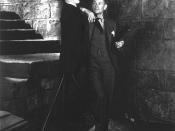The camera focuses on a wall and a shadow moves across it. Dramatic orchestral music plays and Victor bursts in. He is covered in sweat. As he enters, he sweeps his cloak over his shoulder in a dramatic style and the camera follows him, running through the room. During this time, the background orchestral music is very high tempo, helping to show Victor's determination to bring his creation to life. The atmosphere created is very strange. It communicates Victor's feelings and work as well as showing the darker side of one human artificially creating life "ÃÂ in effect taking on the role of what some people would believe to be the work of god.
As the scene progresses, Victor begins to connect up all the wires. This is shown in a very long shot which allows the viewer to see the entire room, as well as the attic roof. Towards the end of the birthing scene, the creature is up in chains and Victor is down on the ground.
The camera swaps between high and low angle shots to communicate the shift in power. The high-angle shots make Victor appear vulnerable, while the creature is powerful looking in the low-angle shots.
There are a number of religious images in "ÃÂMary Shelley's Frankenstein'. The laboratory where the creature is given life is in an attic, which mirrors the shape of a Cathedral. Flickering candles around the action are the only lighting and they create a church-like illumination. In this scene there are images of both the creature and Victor as if positioned on a cross. A low angle shot shows the creature in chains at the end of the scene. Moments before the creature is born, a very long shot shows Victor on top of the coffin-like container, from which the creature explodes, with outstretched arms commanding the creature to live "ÃÂ as if he is god. There is a fire blazing beneath the container that can be seen as representing hell. A close up of one of the needles going into the creature's foot could also symbolize stigmata. At the end of this scene, the image of Victor reading his journal is similar to that of a priest, leading a sermon. At this point, the creature is positioned hanging above Victor, looking powerful and god-like, creating the feeling of vulnerability as you look up to it.
Machinery in the birthing scene of "ÃÂMary Shelley's Frankenstein' can be seen as representing sexual organs. A huge, brown, balloon-like object positioned above the creature's container illustrates the womb. A glass tube in which the eels swim down looks like a fallopian tube, while the eels themselves could represent the sperm swimming towards the egg.
In this scene there are many similarities between the creature's birth and that of a newborn baby. Unable to breathe, it explodes out of the container, struggling for life. The gushing water is similar to the waters breaking before a woman gives birth. The birth is traumatic, his eyes are closed, and like a newborn baby, he is covered in embryonic fluid. The creature is unsteady and it is incapable of walking. On a small, newborn animal this looks endearing, but on a fully-grown man it looks disgusting and brings home the full extent of what Victor has done.
In James Whale's "ÃÂFrankenstein', the establishing shot of the birthing scene is a close-up on Victor talking to Professor Waldman. Victor seems to be very excited "ÃÂ he talks fast, at a high pitch. Unlike the Kenneth Branagh version, in James Whale's "ÃÂFrankenstein', Victor has an audience. At this time, special effects were limited, so the reactions of the Professor, Henry and Elizabeth are important in adding to the atmosphere of the scene and to show how horrific the event they are witnessing really is. There are a number of close ups on Victor in this scene. He is well dressed, wearing trousers, shirt and tie underneath a long white coat, which, at some points resembles a straight jacket. This has the effect of making him look like a stereotypical scientist. Many close ups of his face show us his facial expressions. His eyes are bulging and the way he stares so hard and then darts his eyes very quickly make him look like a man obsessed. James Whale's Victor is well spoken "ÃÂ he has an upper-class accent. The tone he speaks in is very stern "ÃÂ almost as if there is no questioning what he is going to do. These features combined give the impression that Victor is on the verge of insanity. This is reinforced when he says to his audience: "Quite a good scene, isn't it? One man crazy, three very sane spectators!"ÃÂ He has become frightening; during the scene Elizabeth gets scared by his increasing insanity and is comforted by Henry.
The birthing scene in James Whale's "ÃÂFrankenstein' is set in a prison-like room. It is a science laboratory with a lot of equipment. In this version, there is no music. Sound effects used are very limited. A storm is created with lots of thunder, and the gasps from Victor's spectators show their reactions without the camera having to focus on them. The special effects are also limited, due to the time that the film was made, which was nearly 70 years ago. One special effect is the monster being hoisted up into the storm to gain electrical charge from the lightening. A medium-high angle shot shows the creature as it moves up to the sky light, the camera follows the bed as it moves. Although this is commonly used now, it was a sophisticated shot for the time. A close up shot shows the creatures hand. Even though we cannot see the face at this point, we can tell the creature is alive because the hand begins to move. The scars and stitches on the wrists show that it is the monster.
The two versions of "ÃÂFrankenstein' are very different. The use of modern technology stands out as a difference, but also the portrayal of Victor. In the James Whale version, Victor conforms to the stereo typical "ÃÂmad scientist'. He wears a suit covered by a lab coat and behaves in an eccentric way. Kenneth Branagh's portrayal is very different, instead of implying a slightly mad, upper class professor, he gives the impression of a crazed, obsessive man whose unhealthy quest to create life has left him unable to reason and incapable of seeing the moral implications of what he is doing.
The birth of James Whale's "ÃÂFrankenstein' is very short and simple "ÃÂ he is pushed into the storm, pulled down again and comes to life. In the Kenneth Branagh film, the special effects at this point are much more elaborate, involving more visible action.
Having seen both versions, I prefer the Kenneth Branagh adaptation. I think his portrayal of Victor shows the darker side of the situation in the way he looks. The atmosphere in this version can be detected much more clearly than in the James Whale version, where everything seems to be fairly tame and civilized. Dramatic music in the Kenneth Branagh version also helps to create moods. This version also incorporates lots of hidden detail. Earlier, I looked at religious and sexual imagery that can be seen. These give another view to the story that helps to make us understand the character's situation. This detail is lacking from the James Whale version.
The James Whale is considered by many people to be a classic because it is still being watched some 70 years later. Although "ÃÂMary Shelley's Frankenstein' by Kenneth Branagh is still too modern to be considered a classic, I think in years to come it will still be being watched as one of the best "ÃÂFrankenstein' adaptations.
I think "ÃÂFrankenstein' is the type of film that improves as technology develops, allowing better special effects, and, to some extent, reality. The Kenneth Branagh version pays more attention to detail and I preferred his portrayal of Victor. I think this makes Kenneth Branagh's "ÃÂMary Shelley's Frankenstein' more effective.





